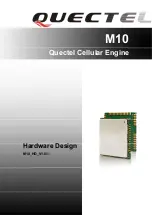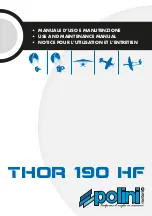
Not for
Reproduction
High Altitude
At altitudes over 5,000 feet (1524 meters), a minimum 85 octane/85 AKI (89 RON) gasoline
is acceptable.
For carbureted engines, high altitude adjustment is required to maintain performance.
Operation without this adjustment will cause decreased performance, increased fuel
consumption, and increased emissions. Contact a Briggs & Stratton Authorized Service
Dealer for high altitude adjustment information. Operation of the engine at altitudes below
2,500 feet (762 meters) with the high altitude adjustment is not recommended.
For Electronic Fuel Injection (EFI) engines, no high altitude adjustment is necessary.
Add Fuel
See Figure: 6
WARNING
Fuel and its vapors are extremely flammable and explosive.
Fire or explosion can cause severe burns or death.
When adding fuel
•
Turn engine off and let engine cool at least 2 minutes before removing the fuel cap.
•
Fill fuel tank outdoors or in well-ventilated area.
•
Do not overfill fuel tank. To allow for expansion of the fuel, do not fill above the bottom
of the fuel tank neck.
•
Keep fuel away from sparks, open flames, pilot lights, heat, and other ignition sources.
•
Check fuel lines, tank, cap, and fittings frequently for cracks or leaks. Replace if
necessary.
•
If fuel spills, wait until it evaporates before starting engine.
1.
Clean the fuel cap area of dirt and debris. Remove the fuel cap.
2.
Fill the fuel tank (A, Figure 6) with fuel. To allow for expansion of the fuel, do not fill
above the bottom of the fuel tank neck (B).
3.
Reinstall the fuel cap.
Start and Stop Engine
See Figure: 7
Start Engine
WARNING
Fuel and its vapors are extremely flammable and explosive.
Fire or explosion can cause severe burns or death.
When Starting Engine
•
Ensure that spark plug, muffler, fuel cap and air cleaner (if equipped) are in place
and secured.
•
Do not crank engine with spark plug removed.
•
If engine floods, set choke (if equipped) to OPEN or RUN position, move throttle (if
equipped) to FAST position and crank until engine starts.
WARNING
POISONOUS GAS HAZARD. Engine exhaust contains carbon monoxide, a
poisonous gas that could kill you in minutes. You CANNOT see it, smell it, or taste
it. Even if you do not smell exhaust fumes, you could still be exposed to carbon
monoxide gas. If you start to feel sick, dizzy, or weak while using this product,
shut it off and get to fresh air RIGHT AWAY. See a doctor. You may have carbon
monoxide poisoning.
•
Operate this product ONLY outside far away from windows, doors and vents to reduce
the risk of carbon monoxide gas from accumulating and potentially being drawn
towards occupied spaces.
•
Install battery-operated carbon monoxide alarms or plug-in carbon monoxide alarms
with battery back-up according to the manufacturer's instructions. Smoke alarms
cannot detect carbon monoxide gas.
•
DO NOT run this product inside homes, garages, basements, crawlspaces, sheds,
or other partially-enclosed spaces even if using fans or opening doors and windows
for ventilation. Carbon monoxide can quickly build up in these spaces and can linger
for hours, even after this product has shut off.
•
ALWAYS place this product downwind and point the engine exhaust away from
occupied spaces.
NOTICE
This engine was shipped from Briggs & Stratton without oil. Before you start
the engine, make sure you add oil according to the instructions in this manual. If you
start the engine without oil, it will be damaged beyond repair and will not be covered
under warranty.
Determine The Starting System
Before starting the engine, you must determine the type of starting system that is on your
engine. Your engine will have one of the following types.
•
Electronic Fuel Injection (EFI) System: This features Electronic Fuel Injection. It
does not have a choke or a primer.
•
Choke System: This features a choke to be used for starting in cool temperatures.
Some models will have a separate choke control while others will have a combination
choke and throttle control. This type does not have a primer.
Note: Equipment may have remote controls. See the equipment manual for location and
operation of remote controls.
Electronic Fuel Injection (EFI) System
1.
Check the engine oil. See the
Check Oil Level section.
2.
Make sure equipment drive controls, if equipped, are disengaged.
3.
Move the fuel shut-off (A, Figure 7), if equipped, to the OPEN position.
4.
Move the throttle control (B, Figure 7), if equipped, to the FAST position. Operate
the engine in the FAST position.
5.
Push the stop switch (D, Figure 7), if equipped, to the ON position.
6.
Turn the electric start switch (E, Figure 7) to the ON or START position.
NOTICE
To extend the life of the starter, use short starting cycles (five seconds
maximum). Wait one minute between starting cycles.
Note: If the engine does not start after repeated attempts, contact you local dealer or go
to VanguardEngines.com or call 1-800-999-9333 (in USA).
Choke System
1.
Check the engine oil. See the
Check Oil Level section.
2.
Make sure equipment drive controls, if equipped, are disengaged.
3.
Move the fuel shut-off (A, Figure 7), if equipped, to the OPEN position.
4.
Move the throttle control (B, Figure 7), if equipped, to the FAST position. Operate
the engine in the FAST position.
5.
Move the choke control (C, Figure 7), or the combination choke and throttle (B, C),
to the CLOSED position.
Note: To start the engine with a dry fuel system (first time starting or after running out of
fuel), additional cranking time in the choke position will be required. This will give the fuel
pump time to prime the fuel system.
6.
Push the stop switch (D, Figure 7), if equipped, to the ON position.
7.
Turn the key switch (E, Figure 7) to the ON or START position.
8.
If the engine fires but will not continue to run, move the choke control (C, Figure 7)
to the OPEN position to start the engine.
NOTICE
To extend the life of the starter, use short starting cycles (five seconds
maximum). Wait one minute between starting cycles.
9.
As the engine warms up, move the choke control (C, Figure 7) to the OPEN position.
Note: If the engine does not start after repeated attempts, contact you local dealer or go
to VanguardEngines.com or call 1-800-999-9333 (in USA).
Stop Engine
WARNING
Fuel and its vapors are extremely flammable and explosive.
Fire or explosion can cause severe burns or death.
•
Do not choke the carburetor, if equipped, to stop the engine.
1.
Stop Switch, if equipped: Move the stop switch (D, Figure 7) to the OFF position.
Key Switch, if equipped: With the throttle control in the SLOW position, turn the
key switch (E, Figure 7) to the OFF position. Remove the key and keep in a safe
place out of the reach of children.
8
Содержание 54E100
Страница 2: ...N o t f o r R e p r o d u c t i o n 1 2 3 4 5 6 7 2 VanguardEngines com...
Страница 3: ...N o t f o r R e p r o d u c t i o n 8 9 10 11 12 13 14 B C B 3...
Страница 4: ...N o t f o r R e p r o d u c t i o n 15 16 17 18 19 4 VanguardEngines com...
Страница 34: ...N o t f o r R e p r o d u c t i o n...
Страница 35: ...N o t f o r R e p r o d u c t i o n...
Страница 36: ...N o t f o r R e p r o d u c t i o n...









































